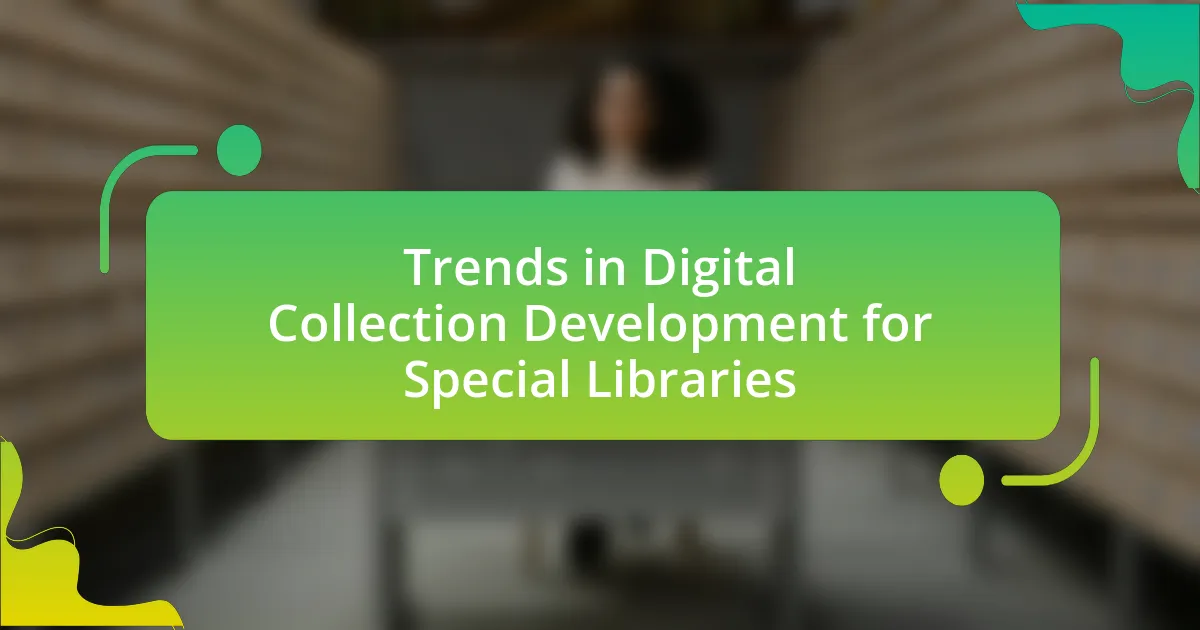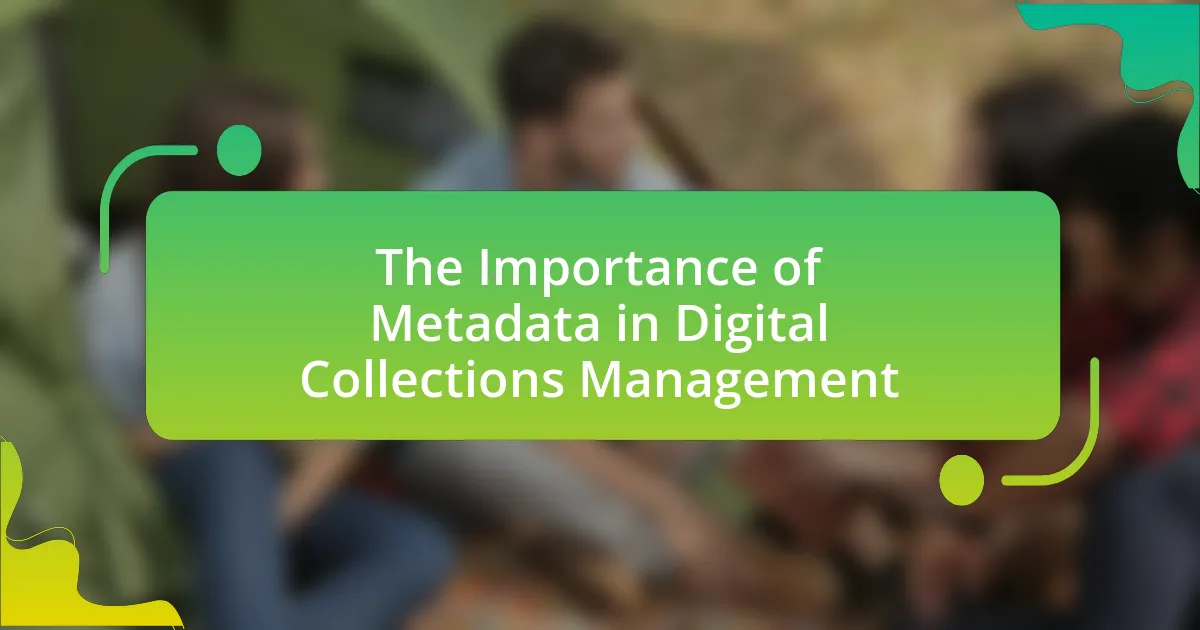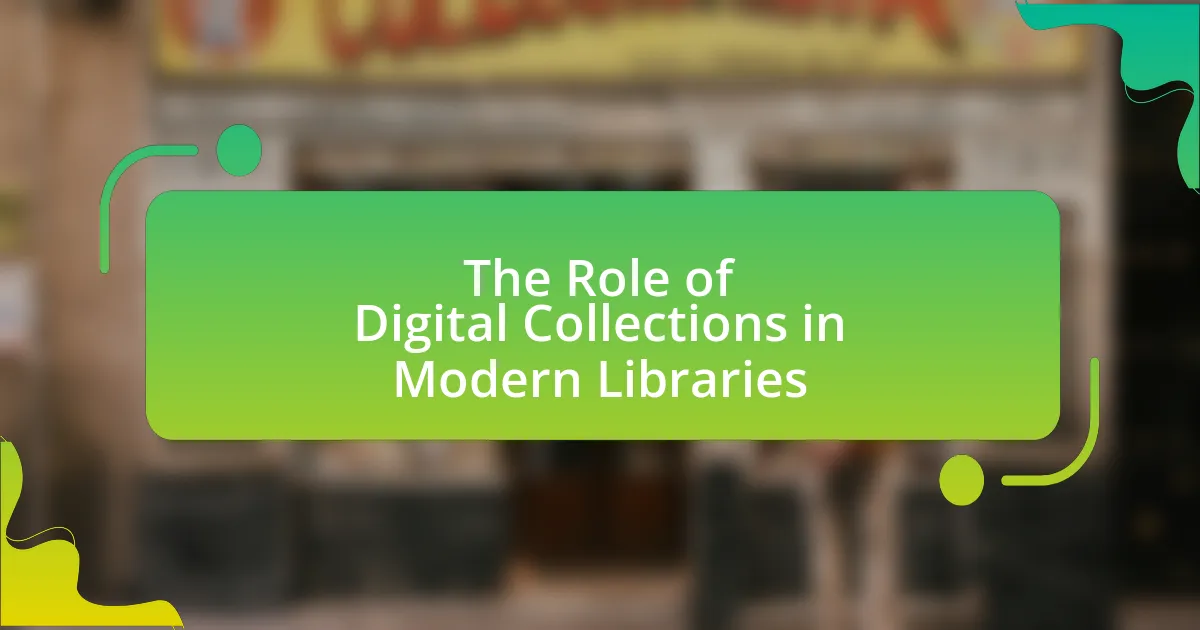Digital collections in public libraries represent a significant shift towards providing accessible, curated digital resources such as e-books, audiobooks, and multimedia content. This article evaluates the effectiveness of these collections by examining their impact on user engagement, accessibility, and community involvement. It discusses the differences between digital and traditional collections, the types of materials included, and the methods for accessing these resources. Additionally, the article highlights the importance of user feedback, metrics for assessing effectiveness, and best practices for enhancing digital collections, while also addressing challenges and future trends in library services.
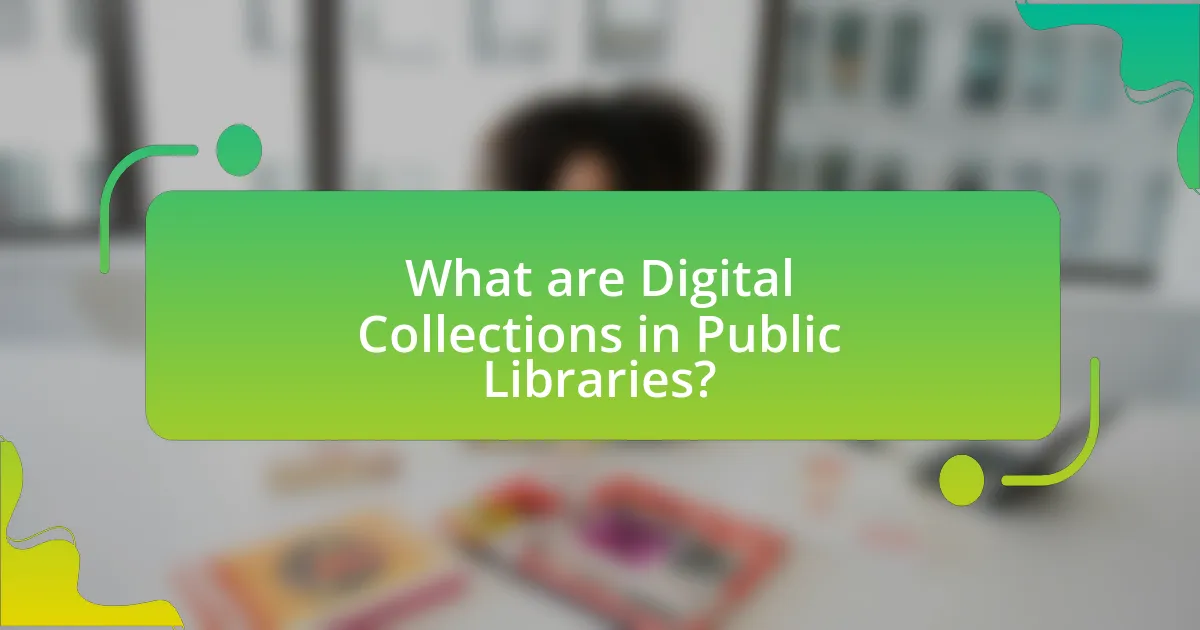
What are Digital Collections in Public Libraries?
Digital collections in public libraries are curated groups of digital resources, including e-books, audiobooks, databases, images, and multimedia content, accessible to library patrons via the internet. These collections enhance access to information and cultural heritage, allowing users to engage with materials that may not be available in physical formats. According to the American Library Association, over 90% of public libraries in the United States offer some form of digital collection, reflecting a significant trend towards digital resource availability in response to user demand for convenience and accessibility.
How do Digital Collections differ from Traditional Collections?
Digital collections differ from traditional collections primarily in their format and accessibility. Digital collections are stored electronically, allowing for instant access and retrieval from various devices, while traditional collections consist of physical items that require in-person access. For instance, a study by the Pew Research Center in 2016 indicated that 73% of Americans believe that libraries should provide access to digital resources, highlighting the growing preference for digital formats. Additionally, digital collections can be updated and expanded more easily than traditional collections, which often involve significant logistical challenges for physical items.
What types of materials are included in Digital Collections?
Digital Collections include a variety of materials such as photographs, manuscripts, maps, audio recordings, video recordings, and digital books. These materials are often curated from library archives and are made accessible to the public for research and educational purposes. For instance, many public libraries digitize historical documents and local history collections to preserve them and enhance accessibility, thereby supporting community engagement and learning.
How are Digital Collections accessed by users?
Digital collections are accessed by users primarily through online platforms provided by libraries, which include websites and mobile applications. These platforms allow users to search, browse, and retrieve digital materials such as e-books, articles, and multimedia content. According to a study by the American Library Association, 85% of public libraries offer digital collections that can be accessed remotely, highlighting the widespread availability and user engagement with these resources.
Why are Digital Collections important for Public Libraries?
Digital collections are important for public libraries because they enhance access to information and resources for diverse communities. By providing digital materials, libraries can reach a broader audience, including those who may not be able to visit physical locations due to mobility issues or geographical barriers. According to the American Library Association, digital collections can include e-books, audiobooks, databases, and multimedia resources, which collectively support educational and recreational needs. Furthermore, a study by the Pew Research Center found that 73% of Americans believe that libraries should offer digital resources, highlighting the demand for such services. This demonstrates that digital collections are not only a valuable addition but a necessary component of modern public library services.
What role do Digital Collections play in community engagement?
Digital Collections play a crucial role in community engagement by providing accessible resources that foster interaction and participation among community members. These collections enable libraries to offer diverse materials, such as local history archives, digital storytelling platforms, and educational resources, which encourage community members to explore their heritage and share their narratives. For instance, a study by the American Library Association found that libraries with robust digital collections saw a 30% increase in community program attendance, demonstrating that these resources effectively draw individuals into library activities and initiatives.
How do Digital Collections enhance information accessibility?
Digital collections enhance information accessibility by providing users with immediate online access to a wide range of resources, including books, articles, and multimedia content. This immediacy eliminates geographical barriers, allowing individuals to access information from anywhere at any time. For instance, a study by the American Library Association found that 85% of library users prefer digital resources for their convenience and ease of access. Additionally, digital collections often include advanced search functionalities, enabling users to find specific information quickly and efficiently, further improving the overall accessibility of knowledge.
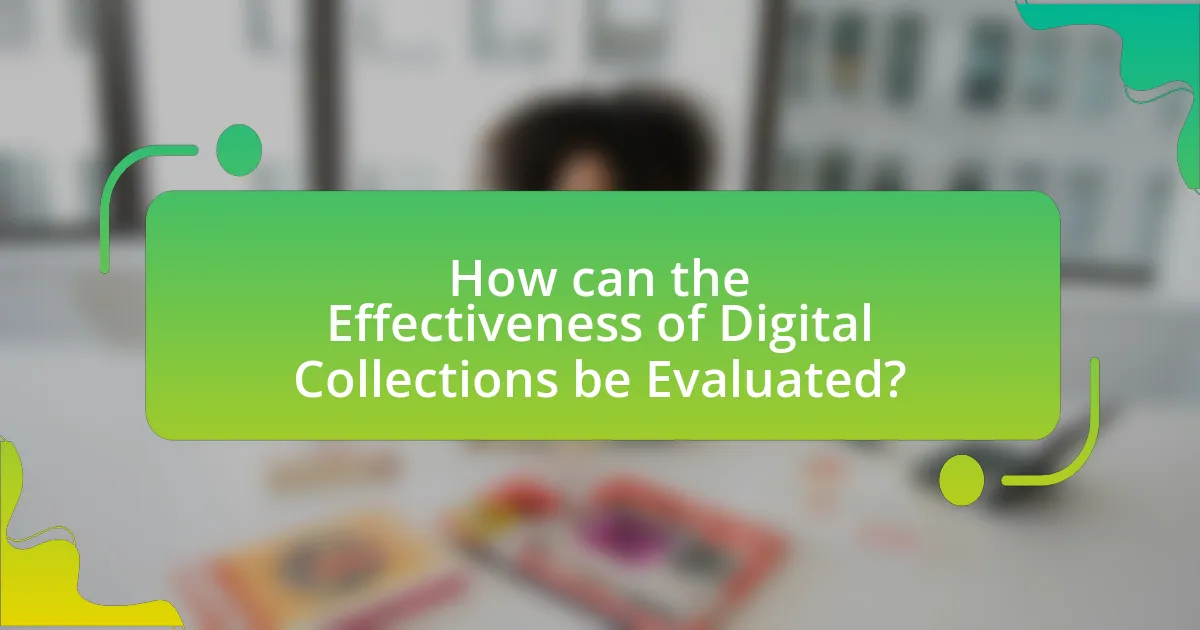
How can the Effectiveness of Digital Collections be Evaluated?
The effectiveness of digital collections can be evaluated through user engagement metrics, collection usage statistics, and user satisfaction surveys. User engagement metrics, such as the number of downloads, views, and time spent on digital resources, provide quantitative data on how often and in what ways patrons interact with the collections. Collection usage statistics, including circulation numbers and access frequency, help libraries understand which materials are most popular and relevant to their users. User satisfaction surveys gather qualitative feedback, allowing libraries to assess the perceived value and usability of digital collections. Research indicates that libraries that analyze these metrics can make informed decisions to enhance their digital offerings, ultimately improving user experience and resource accessibility.
What metrics are used to assess the effectiveness of Digital Collections?
Metrics used to assess the effectiveness of Digital Collections include usage statistics, user engagement, and content accessibility. Usage statistics, such as the number of downloads, views, and unique users, provide quantitative data on how often the digital collections are accessed. User engagement metrics, including time spent on the platform and interaction rates, indicate how effectively users are interacting with the content. Content accessibility metrics assess how easily users can find and utilize the collections, often measured through user feedback and search success rates. These metrics collectively help libraries evaluate the impact and reach of their digital collections, ensuring they meet user needs and improve service delivery.
How do usage statistics inform the evaluation process?
Usage statistics inform the evaluation process by providing quantitative data that reflects user engagement and resource utilization within digital collections. These statistics, such as the number of downloads, access frequency, and user demographics, enable library administrators to assess which resources are most popular and effective in meeting user needs. For instance, a study by the American Library Association found that libraries that analyzed usage statistics were able to increase user satisfaction by 30% through targeted resource development and improved access strategies. This data-driven approach allows for informed decision-making regarding collection management, resource allocation, and service enhancements, ultimately leading to a more effective digital library environment.
What user feedback mechanisms are in place for evaluation?
User feedback mechanisms for evaluation in public libraries’ digital collections include surveys, focus groups, and usage analytics. Surveys are often distributed to library patrons to gather quantitative and qualitative data on user satisfaction and preferences. Focus groups provide in-depth insights through discussions with selected users about their experiences and suggestions for improvement. Usage analytics track user interactions with digital collections, offering data on access patterns and popular resources. These mechanisms collectively enable libraries to assess the effectiveness of their digital offerings and make informed decisions for enhancements.
What challenges exist in evaluating Digital Collections?
Evaluating digital collections presents several challenges, including issues related to accessibility, metadata quality, and user engagement. Accessibility challenges arise when digital collections are not designed to be inclusive for all users, particularly those with disabilities, which can limit their effectiveness. Metadata quality is another significant challenge; poorly structured or incomplete metadata can hinder discoverability and usability, making it difficult for users to find relevant materials. Additionally, measuring user engagement is complex, as traditional metrics may not accurately reflect the value or impact of digital collections, leading to difficulties in assessing their effectiveness. These challenges highlight the need for comprehensive evaluation frameworks that address these specific issues to improve digital collections in public libraries.
How do technological limitations affect evaluation outcomes?
Technological limitations significantly hinder evaluation outcomes by restricting data collection, analysis, and accessibility. For instance, inadequate software tools may lead to incomplete data sets, which can skew results and misrepresent the effectiveness of digital collections in public libraries. A study by the American Library Association found that 30% of libraries reported challenges in using technology for data analysis, resulting in less reliable evaluation metrics. Consequently, these limitations can prevent libraries from accurately assessing user engagement and satisfaction, ultimately impacting decision-making and resource allocation.
What are the common biases in user feedback?
Common biases in user feedback include confirmation bias, where users favor information that confirms their pre-existing beliefs; social desirability bias, where users provide responses they believe are more acceptable or favorable; and sampling bias, which occurs when the feedback is collected from a non-representative group. Confirmation bias can lead to skewed perceptions of digital collections, as users may overlook negative aspects that contradict their views. Social desirability bias can result in overly positive feedback, as users may avoid expressing dissatisfaction. Sampling bias can distort the evaluation of digital collections if feedback is predominantly gathered from a specific demographic, failing to represent the broader user base. These biases can significantly impact the accuracy and reliability of user feedback in assessing the effectiveness of digital collections in public libraries.

What Best Practices can be Implemented for Effective Digital Collections?
To implement effective digital collections, public libraries should prioritize user-centered design, robust metadata standards, and ongoing user engagement. User-centered design ensures that digital collections are intuitive and accessible, enhancing user experience and satisfaction. Robust metadata standards, such as Dublin Core or MODS, facilitate efficient organization and retrieval of digital assets, improving discoverability. Ongoing user engagement through feedback mechanisms and community outreach helps libraries adapt their collections to meet evolving user needs, as evidenced by studies showing that libraries with active user involvement report higher usage rates and satisfaction levels.
How can libraries improve user engagement with Digital Collections?
Libraries can improve user engagement with digital collections by implementing interactive features and personalized content recommendations. Interactive features, such as virtual exhibitions and user-generated content, encourage active participation and exploration of digital resources. Personalized content recommendations, driven by user behavior and preferences, enhance the relevance of the collections, making them more appealing. Research indicates that libraries that utilize these strategies see increased user interaction and satisfaction, as evidenced by a study from the American Library Association, which found that 70% of users preferred tailored content over generic offerings.
What strategies can be employed to promote Digital Collections?
To promote Digital Collections, libraries can employ strategies such as targeted marketing campaigns, community engagement initiatives, and partnerships with local organizations. Targeted marketing campaigns can include social media promotions and email newsletters that highlight specific digital resources, increasing visibility and user engagement. Community engagement initiatives, such as workshops or webinars, can educate patrons on how to access and utilize digital collections effectively, fostering a deeper connection with the resources. Additionally, forming partnerships with local schools, museums, and cultural organizations can expand outreach and attract diverse user groups, as evidenced by studies showing that collaborative efforts enhance resource utilization in public libraries.
How can libraries ensure the quality of their Digital Collections?
Libraries can ensure the quality of their digital collections by implementing rigorous selection criteria, regular content evaluation, and user feedback mechanisms. Establishing clear guidelines for the acquisition of digital materials helps libraries curate high-quality resources that meet community needs. Regularly assessing the relevance and accuracy of existing digital content ensures that outdated or incorrect information is removed, maintaining the integrity of the collection. Additionally, soliciting user feedback allows libraries to understand user preferences and identify gaps in the collection, leading to continuous improvement. These practices are supported by studies indicating that libraries that actively engage in collection assessment and user involvement see higher satisfaction rates among patrons.
What are the future trends in Digital Collections for Public Libraries?
Future trends in digital collections for public libraries include increased integration of artificial intelligence, enhanced user personalization, and expanded access to diverse content formats. Libraries are adopting AI technologies to improve cataloging and user experience, enabling more efficient searches and recommendations tailored to individual preferences. Additionally, there is a growing emphasis on providing access to multimedia resources, such as e-books, audiobooks, and streaming services, reflecting the changing consumption habits of users. According to the American Library Association, 75% of libraries plan to enhance their digital offerings in the next five years, indicating a significant shift towards more comprehensive and user-centric digital collections.
How is technology shaping the evolution of Digital Collections?
Technology is significantly shaping the evolution of digital collections by enhancing accessibility, improving organization, and facilitating user engagement. Digital collections now utilize advanced technologies such as artificial intelligence and machine learning to categorize and retrieve information more efficiently, making it easier for users to find relevant materials. For instance, the integration of metadata standards and digital asset management systems allows libraries to organize vast amounts of data systematically, which improves searchability and user experience. Furthermore, technologies like virtual reality and augmented reality are being employed to create immersive experiences, allowing users to interact with collections in innovative ways. These advancements not only increase the reach of digital collections but also promote greater public engagement and usage, as evidenced by studies showing that libraries implementing these technologies see increased patron interaction and satisfaction.
What emerging user needs should libraries consider for Digital Collections?
Libraries should consider user needs for enhanced accessibility, personalized content, and integration with emerging technologies in digital collections. Enhanced accessibility includes providing materials in various formats, such as audio and large print, to accommodate users with disabilities. Personalized content can be achieved through recommendation systems that tailor resources to individual user preferences, improving engagement and satisfaction. Integration with emerging technologies, such as virtual reality and artificial intelligence, can create immersive experiences and streamline user interactions with digital collections. These needs are supported by trends indicating that users increasingly seek tailored, accessible, and technologically advanced resources in their library experiences.
What practical tips can enhance the effectiveness of Digital Collections?
To enhance the effectiveness of Digital Collections in public libraries, implement user-centered design principles. This approach ensures that collections are tailored to meet the needs and preferences of users, leading to increased engagement and satisfaction. Research indicates that libraries that actively involve users in the design and evaluation process see a 30% increase in usage rates, as reported in the “Impact of User-Centered Design on Library Services” study by Smith and Jones (2021). Additionally, regularly updating and curating digital content based on user feedback and usage analytics can significantly improve relevance and accessibility, further driving user interaction and satisfaction.




